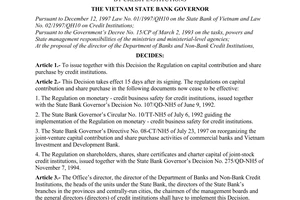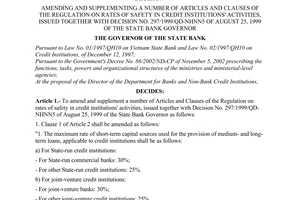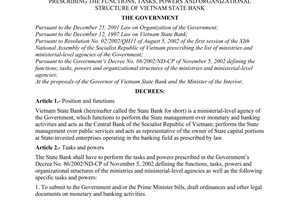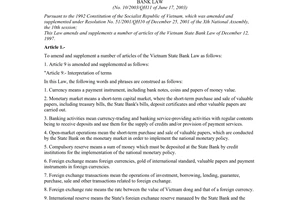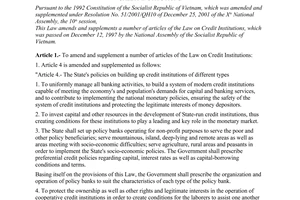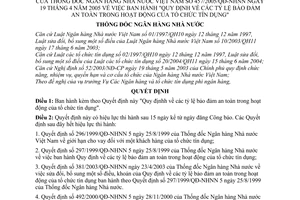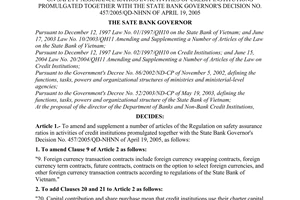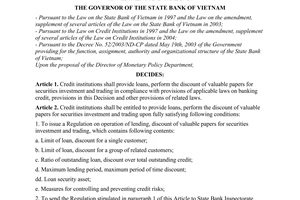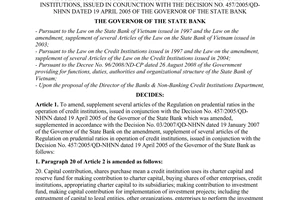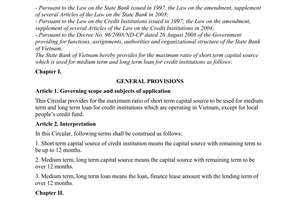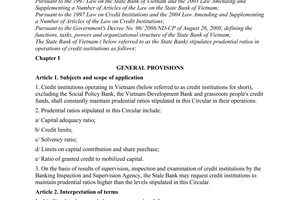Decision No. 457/2005/QD-NHNN of April 19, 2005, on the issuance of the regulation on prudential ratios in the activities of credit institutions đã được thay thế bởi Circular No. 13/2010/TT-NHNN stipulating prudential ratios in operations và được áp dụng kể từ ngày 01/10/2010.
Nội dung toàn văn Decision No. 457/2005/QD-NHNN of April 19, 2005, on the issuance of the regulation on prudential ratios in the activities of credit institutions
|
THE
STATE BANK OF VIETNAM |
SOCIALIST
REPUBLIC OF VIETNAM |
|
No. 457/2005/QD-NHNN |
Hanoi, April 19, 2005 |
DECISION
ON THE ISSUANCE OF THE REGULATION ON PRUDENTIAL RATIOS IN THE ACTIVITIES OF CREDIT INSTITUTIONS
THE GOVERNOR OF THE STATE BANK
- Pursuant to the Law on the
State Bank No. 01/1997/QH10 dated 12 December 1997, the Law on the amendment, supplement
of several Articles of the Law on the State Bank No. 10/2003/QH11 dated 17 June
2003;
- Pursuant to the Law on the Credit Institutions No. 02/1997/QH10 dated 12
December 1997; the Law on the amendment, supplement of several Articles of the
Law on the Credit Institutions No. 20/2004/QH11 dated 15 June 2004;
- Pursuant to the Decree No. 52/2003/ND-CP dated 19 May 2003 of the Government
providing for functions, assignments, authorities and organizational structure
of the State Bank of Vietnam;
- Upon the proposal of the Director of the Banks & Non-Bank Credit
Institutions Department,
DECIDES:
Article 1. To issue in conjunction with this Decision "the Regulation on prudential ratios in the activities of credit institutions.
Article 2. This Decision shall be effective after 15 days since its publication in the Official Gazette. Following Decisions shall cease their effectiveness:
1. The Decision No. 296/1999/QD-NHNN dated 25 August 1999 of the Governor of the State Bank on lending limit to a single customer by a credit institution;
2- The Decision No. 297/1999/QD-NHNN dated 25 August 1999 of the Governor of the State Bank on the issuance of the Regulation on prudential ratios in the activities of credit institutions;
3. The Decision No. 381/2003/QD-NHNN5 dated 23 April 2003 of the Governor of the State Bank on the amendment, supplement of several Articles, paragraphs of the Regulation on prudential ratios in the activities of credit institutions issued in conjunction with the Decision No. 297/1999/QD-NHNN5 dated 25 August 1999 of the Governor of the State Bank;
4. The Decision No. 492/2000/QD-NHNN5 dated 28 November 2000 of the Governor of the State Bank on the issuance of the Regulation on the capital contribution, share purchase by credit institutions.
Article 3. The Director of the Administration Department, the Director of the Banks and Non-Bank Credit Institutions Department, Heads of units of the State Bank, General Managers of State Bank branches in provinces and cities, Chairman of the Board of Directors, General Directors (Directors) of credit institutions shall be responsible for the implementation of this Decision.
|
|
THE
GOVERNOR OF THE STATE BANK |
REGULATION
ON PRUDENTIAL RATIOS IN THE ACTIVITIES OF CREDIT
INSTITUTIONS
(issued in conjunction with the Decision No. 457/2005/QD-NHNN dated 19 April
2005 of the Governor of the State Bank)
I. GENERAL PROVISIONS
Article 1.
1. Credit institutions operating in Vietnam (hereinafter referred to as credit institution), except for local Peoples Credit Funds, shall maintain following prudential ratios:
a. The minimum capital adequacy ratio;
b. The credit limit to customers
c. The liquidity ratio;
d. The maximum ratio of short-term funds used for granting medium-term and long-term loans;
dd. The limit on the capital contribution, share purchase;
2. The prudential ratios provided for in paragraph 1 of this Article do not include those of subsidiary credit institutions.
3. Based on inspection, examination result of the State Bank Inspectorate on the operational performance of credit institutions, the State Bank may request the credit institutions to maintain prudential ratios, which are more restrictive than levels stipulated in Article 4 and Article 8 of this Regulation.
Article 2.
In this Regulation, following terms shall be construed as follows:
1. The total risk adjusted assets include the value of assets of credit institutions which are adjusted to the risk level provided for in Article 6 and off-balance sheet commitments which are adjusted to the risk level as provided for in Article 5 of this Regulation.
2. Claims are on-balance sheet assets, which are created from deposits, loans, advances, investments, discounts, rediscounts and financial leases.
3. Immovable assets of the borrowing party are houses of the borrowing party, or houses which are leased by the borrowing party and accepted by the lessee to be used as pledged assets during the lease time.
4. A single customer is a legal entity, an individual, a family household, a cooperative group, a private enterprise, a partnership company, or other organizations that have credit relationships with a credit institution.
5. A group of related customers includes 2 or several customers who have credit relationships with a credit institution, belonging to one of following cases:
5.1. Ownership relation:
5.1.1. An individual customer who owns at least 25% of charter capital of another customer, which is also a legal entity; or
5.1.2. A legal entity customer who owns at least 50% of charter capital of another customer, which is also a legal entity.
5.2.1. Administrative, managerial, membership relation:
5.2.1. For an individual customer:
a. Who is a member of a family household in accordance with provisions in the Civil Code, which is a customer of the credit institution; or
b. Who is a team member of a cooperative group in accordance with provisions in the Civil Code, which is a customer of the credit institution; or
c. Who is a partner of a partnership company, which is a customer of the credit institution; or
d. Who is an owner of a private enterprise, which is a customer of the credit institution; or
dd. Who is holding the post of an administrator, a manager, a controller in the organizational structure of another legal entity customer of the credit institution (such as Chairman of the Board of Directors or General Director (Director), Chief of Controllers Committee in respect of the State owned enterprises, joint stock companies; Chairman of Members Board, General Director (Director), Chief of Controllers Committee in respect of Limited Liability Companies with 2 members and more; Chairman of the Board of Directors or Companys President, General Director (Director) in respect of Limited Liability Companies with one member).
5.2.2. A legal entity customer whose representative is holding the post of an administrator, a manager, controller in the organizational structure of another legal entity customer of the credit institution (Chairman of the Board of Directors, Chairman of Members Board, General Director (Director), Chief of Controllers Committee).
5.3. Credit institutions shall be entitled to issue stipulations, which are more restrictive and specific than provisions in paragraph 5 of this Article to secure the prudence in banking activities.
6. Total outstanding loans (including payment made in lieu of customers) shall include outstanding balance of current debts, outstanding balance of overdue debts, outstanding balance of frozen debts and outstanding balance of debts pending settlement of credit institutions.
7. Total of financial leasing level shall include outstanding balance of current debts and overdue debts from financial leasing of a financial leasing company.
8. Interest rate transaction contract shall include interest rate swap contract, interest rate forward contract and interest rate options contract.
9. Foreign currency transaction contract shall include foreign currency swap contract, foreign currency forward contract and foreign currency options contract.
10. Investment securities shall be the securities hold by the credit institutions for the profit purpose, not for resale on the market to enjoy price difference
11. Undistributed profits shall be the profits, which are determined through auditing by an independent auditing institution after the tax payment and setting up of funds have been completed in accordance with provisions of applicable laws and retained for the credit institutions capital supplement in accordance with provisions of applicable laws. Undistributed profits of joint stock credit institutions must be approved by Shareholders Meeting.
12. Goodwill shall be the positive difference between the amount used for acquiring a financial asset and the book value of that financial asset. This financial asset shall be fully reflected on the balance sheet of the credit institution.
13. OECD is the abbreviation for the Organization for Economic Cooperation Development
14. IBRD is the abbreviation for the International Bank for Reconstruction and Development
15. IADB is the abbreviation for the Inter-American Development Bank
16. ADB is the abbreviation for the Asian Development Bank
17. AfDB is the abbreviation for the Africa Development Bank
18. EIB is the abbreviation for the European Investment Bank
19. EBRD is the abbreviation for the European Bank for Reconstruction and Development
II. DETAIL PROVISIONS
Section I. OWN CAPITAL
Article 3.
1. The own capital of a credit institution includes:
1.1. Tier 1 capital:
a. The charter capital (appropriated capital, contributed capital)
b. The reserve fund for supplement of the charter capital
c. The financial provisions fund
d. The fund for the operation investment and development
dd. Undistributed profits
The Tier 1 capital shall be used as the basis for the determination of the limit on the purchase of, investment in fixed assets of a credit institution.
1.2. Tier 2 capital:
a. 50% of the increased value of fixed assets, which are revaluated under provisions of applicable laws;
b. 40% of the increased value of investment securities (including investment shares and contributed capital), which are revaluated in accordance with provisions of applicable laws;
c. Convertible bonds or preferred shares, which are issued by a credit institution and satisfy following conditions:
(i) Their initial term, remaining term prior to their conversion into common shares are 5 years at the minimum;
(ii) They are not secured by the assets of the credit institution;
(iii) The credit institution is not entitled to repurchase at the requirement of the holder or from the secondary market, or the credit institution is only entitled to repurchase after obtaining the written approval from the State Bank;
(iv). The credit institution is entitled to stop the interests payment and transfer the accumulated interests to the following year in the event where the interest payment will result in the loss in the current years business activity;
(v) In case of liquidation of the credit institution, the holder of convertible bonds is only entitled to receive the payment after the credit institution has completed payment to all other secured and unsecured creditors;
(vi) The increase of interest of the securities can only be made after 5 years from the issue date and for one time during the term prior to their conversion into common shares.
d. Other debt instruments, which satisfy following conditions:
(i) Debt instruments, where the creditors are subordinate to other creditors: in any case, the creditors are only be paid after the credit institution has completely made payment to all other secured and unsecured creditors;
(ii) Their initial term is more than 10 years at the minimum;
(iii) They are not secured by assets of the credit institution;
(iv) The credit institution is entitled to stop the interest payment and transfer the accumulated interests to the following year in the event where the interest payment will result in the loss in the current years business activity;
(v). The credit institution is only entitled to repay its debt to the creditors prior to the maturity after it has obtained the written approval from the State Bank;
(vi) The increase of interest of the debt instrument can only be made after 5 years from the signing of the contract and for one time only during the term of the debt
dd. General provisions, which are equal to 1.25% of the total risk based assets at the maximum.
2. Limitation on the determination of the own capital:
2.1. Limitation on the determination of tier 1 capital: The tier 1 capital must subtract the goodwill
2.2. Limitation on the determination of tier 2 capital:
a. Total value of items, which are stipulated in item c and d, paragraph 1, 2 of this Article shall be equal to 50% of the value of the tier1 capital at the maximum.
b. During the last 5 year period prior to the maturity date, the date of the conversion of debt instruments into common shares, the value of the convertible bonds in the tier 2 capital shall be deducted by 20% each year from the initial value.
c. The total value of the tier 2 capital shall be 100% value of the tier 1 capital at the maximum.
3. Amounts to be deducted from the own capital:
3.1. The total reduced value of the fixed assets due to the revaluation in accordance with provisions of applicable laws.
3.2. The total reduced value of investment securities (including investment shares, contributed capital), which are revaluated in accordance with provisions of applicable laws.
3.3. The total capitals invested by the credit institution in other credit institution in forms of capital contribution, share purchase.
3.4. The amount of the capital contribution, the value of the joint-ventured capital, share purchase in investment funds, other enterprises which exceeds 15% of the own capital of a credit institution.
3.5. The business losses, including accumulated losses.
Section II. Minimum capital adequacy ratio
Article 4.
1. Credit institutions, except for foreign bank branches must maintain a minimum ratio of 8% of the own capital to the total risk adjusted assets.
2. The State owned commercial banks whose minimum capital adequacy ratio as of the effective time of this Regulation is less than the level provided for in paragraph 1 of this Article, shall have to increase their minimum capital adequacy ratio to the stipulated level within a period of 3 years at the maximum. The annual increase shall be at least one third (1/3) of the discrepancy.
3. The determination of the minimum capital adequacy ratio is stated in Appendix A of this Regulation.
Article 5. The risk adjusted assets of the off-balance sheet commitments:
1. Guarantee, financing commitments to customers:
1.1. Conversion factors:
1.1.1. Conversion factor of 100%: Commitments, which are irrevocable but have the same risk level as a direct credit extension, include
a. Loan guarantee;
b. Payment guarantee.
c. Confirmation of letter of credit; standby letter of credit which provides a financial guarantee for loans, securities issuance; Acceptances, including acceptance in form of endorsement, except for bill of exchange acceptance as stipulated in point 1.1.3.b, paragraph 1 of this Article.
1.1.2. Conversion factor of 50%: Commitments, which are irrevocable in respect of the responsibility by the credit institution for the payment in lieu of others, include:
a. Contract performance bonds;
b. Bid bonds;
c. Other forms of guarantee
d. Standby L/c other than those stipulated in point 1.1.1.c, paragraph 1 of this Article
dd. Other commitments with the initial term from one year and more.
1.1.3. Conversion factor of 20%: trade related commitments, including:
a. Irrevocable L/c
b. Acceptance of short term commercial bill of exchange secured by goods
c. Delivery guarantee
d. Other trade related commitments.
1.1.4. Conversion factor of 0%:
a. Revocable L/c
b. Other commitments, which are unconditionally revocable with the initial term of less than one year.
1.2. Risk factors:
The risk factors of the value of off-balance sheet commitments after converting under the provisions in paragraph 1.1.1, 1.1.2 and 1.1.3 of this Article shall be as follows:
1.2.1. Where the commitments are fully secured by the Government, the State Bank of Vietnam or secured fully by cash deposits, savings books, deposits, valuable papers which are issued by the Government, the State Bank of Vietnam: the risk factor shall be 0%.
1.2.2. Where the commitments are secured by immovable assets of the borrowing party: the risk factor shall be 50%
1.2.3. For other cases: the risk factor shall be 100%.
2. Interest rate transaction contracts and foreign currency transaction contracts:
2.1. Conversion factors:
2.1.1. In respect of interest rate transaction contracts:
a. With the initial term of less than 1 year: 0.5%
b. With the initial term from 1 to 2 years: 1.0%
c. With the initial term of 2 years and more: 1.0% for the term of less than 2 years plus (+) 1.0% for each following year.
2.1.2. In respect of foreign currency contracts:
a. With the initial term of less than 1 year: 2.0%
b. With the initial term from 1 to 2 years: 5.0%
c. With the initial term of 2 years and more: 5.0% for the term of less than 2 years plus (+) 3.0% for each following year.
2.2. Risk factors: the risk factor for the value of interest rate transaction contracts and foreign currency transaction contracts after conversion as stated in paragraph 2.1 of this Article shall be 100%.
Article 6.
Current assets shall be classified under the risk weights as follows:
1. The group of assets, which have the risk level of 0%, includes:
a. Cash;
b. Gold;
c. Vietnam dong deposits of the State owned credit institutions which are maintained at the Bank for Social Policy in accordance with the Decree No. 78/2002/ND-CP dated 4 October 2002 of the Government on credits to the poor and other underprivileged persons.
d. Loans from funds financed, entrusted for investment in accordance with trust contracts according to which the credit institution only enjoys trust fees and not subject to any risk.
dd. Claims in Vietnam Dong on Vietnam Government, the State Bank of Vietnam
e. Discount, rediscount of valuable papers issued by the credit institution;
g. Claims in Vietnam Dong which are secured by valuable papers issued by the credit institution; Claims fully secured by cash deposits, savings books, deposits, valuable papers issued by the Government, the State Bank of Vietnam;
h. Claims on the central Governments, Central Banks of OECD countries;
i. Claims, which are secured by the securities of the central governments of OECD countries or secured by the central Governments of OECD countries.
2. The group of assets, which have risk level of 20%, includes:
a. Claims on other domestic and overseas credit institutions, in each kind of currency
b. Claims on Peoples Committee in provinces, cities under the central Governments management; Claims in foreign currency on Vietnams Government, the State Bank of Vietnam
c. Claims, which are secured by valuable papers issued by other credit institutions, which are set up in Vietnam
d. Claims on State owned financial organizations; Claims, which are secured by valuable papers issued by the State owned financial organizations.
dd. Precious metal (except for gold), precious stone
e. Cash, which are in collection process.
g. Claims on IBRD, IADB, ADB, AFDB, EIB, EBRD and those secured by these banks or secured by the securities issued by these banks.
h. Claims on the banks, which are set up in countries of OECD and those secured by these banks.
i. Claims on securities companies, which are set up in the OECD countries, which comply with agreements on capital management and supervision on the risk basis and claims which are secured by these companies.
k. Claims on the banks, which are set up outside the OECD countries, with the remaining term of less than 1 year and claims with the remaining term of less than 1 year, which are guaranteed by these banks.
3. The group of assets which have the risk level of 50%, includes
a. Amounts invested in projects under the contract stipulated in the Decision No. 79/2002/ND-CP dated 25 October 2002 of the Government on the organization and operation of finance companies.
b. Claims secured by immovable assets of the borrowing party
4. The group of assets which have the risk level of 100%, includes:
a. Amounts of the charter capital, which is appropriated to subsidiary companies which are not a credit institution, have a legal status and perform the independent accounting;
b. Investments made in forms of capital contribution to, share purchase in other enterprises, economic organizations.
c. Claims on banks set up in non-OECD countries with the remaining term of 1 year and more.
d. Claims on the central Government of non-OECD countries, except for the case where the loans are made in local currency and the lending sources are in local currency of those respective countries.
dd. Immovable assets, machines, equipment and other fixed assets.
e. Other claims other than those stipulated in paragraph 1, 2 and 3 of this Article.
Section III. CREDIT LIMIT FOR CUSTOMERS
Article 7.
1. Based on this Regulation and actual operation, development strategy, credit institutions other than foreign bank branches must design an internal policy on criteria to determine a single customer and a group of related customers, credit limits applicable to a single customer and a group of related customers, including following contents:
a. The criteria to determine a single customer and a group of related customers;
b. The credit limits applicable to a single customer and a group of related customers;
c. The limits, the maximum ratio of lending, guarantee to an economic industry or an economic area to the total outstanding credit;
d. The strategy for the Assets diversification, the policy and the methodology to monitor loans, guarantees which exceed 5% of the own capital of the credit institutions.
dd. A loan and the sum of loans with value in excess of 10% of the own capital of the credit institutions must be approved by the Board of Directors or the Chairman of the Board of Directors or by the person authorized by the Board of Directors, the Chairman of the Board of Directors.
e. Where related customers have dependent economic relations, the credit institutions should assess carefully, strictly to make accurate decisions and secure the prudence in banking activity.
2. The Board of Directors of a credit institution shall, at least every 6 month or in a special, necessary case, review the situation and the implementation of this policy by their credit institution.
Article 8.
1. Limit on lending, guarantee:
1.1. The total outstanding loans of a credit institution to a single customer must not exceed 15% of the own capital of the credit institution.
The total lending and guarantee level of a credit institution to a single customer must not exceed 25% of the own capital of the credit institution.
1.2. The total outstanding loans of a credit institution to a group of related customers must not exceed 50% of the credit institutions own capital, of which the lending limit to a single customer must not be in excess of the ratio stipulated in paragraph 1.1 of this Article.
The total lending and guarantee level of a credit institution to a group of related customers must not exceed 60% of the credit institutions own capital.
1.3. The total outstanding loans of a foreign bank branch to a single customer shall not be in excess of 15% of the own capital of the foreign bank at the maximum
The total lending and guarantee level of a foreign bank branch to a single customer must not be in excess of 25% of the own capital of the foreign bank.
The total outstanding loans of a foreign bank branch to a group of related customers shall not be in excess of 50% of the own capital of the foreign bank at the maximum, of which the lending limit to a single customer shall not be in excess of 15% of the own capital of the foreign bank.
The total lending and guarantee level of a foreign bank branch to a group of related customers shall not be in excess of 60% of the own capital of the foreign bank at the maximum.
2. Financial leasing limit:
2.1. The total financial leasing level to a single customer must not be in excess of 30% of the own capital of the financial leasing company.
2.2. The total financial leasing level to a group of related customers must not be in excess of 80% of the own capital of the financial leasing company, of which the financial leasing level to a single customer must not be in excess of the ratio stipulated in paragraph 2.1 of this Article.
Article 9.
Limits stipulated in Article 8 of this Regulation shall not be applicable to following cases:
1. Loans, financial leases from entrusted funds of the Government, other credit institutions.
2. Loans to the Government of Vietnam
3. Loans to other credit institutions, which are operating in Vietnam, with the term of less than 1 year.
4. Loans secured by Government Bonds or Bonds issued by the Government of the OECD countries;
5. Loans fully secured by deposits, including also savings deposits, amounts deposited at the credit institutions
6. Loans fully secured by debt securities, which are issued by the credit institutions
7. Loans which are in excess of 15% of the own capital and specifically decided upon by the Prime Minister; loans and guarantee amounts exceeding 25% of the own capital of the credit institution, which are accepted in advance in writing by the State Bank.
Article 10.
As of the effective time of this Regulation, credit institutions, which have extended loans, issued guarantees, made financial leases, which are in excess of the ratios stipulated in Article 8 of this Regulation, shall not be entitled to extend further loan, issue further guarantee or make further financial lease to customers with ratios exceeding the above-stipulated level and at the same time must take measures to assure the stipulated ratios to be complied within a period of 3 years at the maximum, except for cases approved by the State Bank.
Section IV. THE LIQUIDITY RATIO
Article 11.
Credit institutions must base on provisions in the Regulation, other provisions of applicable laws and their actual operation to issue an internal regulation on the liquidity management for the prudence in the banking activity. The internal Regulation on the liquidity management of the credit institution shall contain following contents:
1. To set up an unit (from the division level or similar level upward) in charge of the strategic liquidity management and policy, which is controlled daily by an division Head or equivalent officer and put under the direct management of a member of the Management Board.
2. To make anticipations and plans (including contingency plan) to secure the payment capacity, liquidity in case of temporary shortage of the payment capacity as well as in case of liquidity crisis.
3. To set up an early warning system of the temporary shortage of the payment capacity and optimal solutions.
4. Policies on the treasury management, the management of daily receipt, payment and source of funds and policies on the holding of the highly liquid valuable papers.
5. Solutions and policies relating to the control and maintenance of payment capacity for each kind of currency, gold.
Article 12.
The credit institutions must regularly secure the liquidity ratio for each kind of currency and gold as follows:
1. The minimum ratio of the value of current assets to the current liabilities, which become due within one month to come, is 25%
2. The minimum ratio of the total current assets, which can be payable within the next 7 working days to the total current liabilities, which must be payable within the next 7 working days is 1.
Article 13.
1. Current Assets shall include:
a. Cash;
b. Gold
c. Deposits at the State Bank
d. The positive difference between demand deposits at other credit institutions and demand deposits from those credit institutions;
dd. Time deposits at other credit institutions which have become due
e. Securities issued or guaranteed by the Government of Vietnam:
(i) With the remaining term of 1 year and less: 100% of the book value
(ii) With the remaining term of more than 1 year: 95% of the book value
g. Securities issued or guaranteed by credit institutions which are operating in Vietnam:
(i) With the remaining term of 1 month and less: 100% of the book value
(ii) With the remaining term of more than 1 month to 1 year: 95% of the book value
(iii) With the remaining term of more than 1 year: 90% of the book value
h. Securities issued by the government of OECD countries
(i) With the remaining term of 1 year and less: 100% of the book value
(ii) With the remaining term of more than 1 year: 95% of the book value
i. Securities issued by banks of OECD countries:
(i) With the remaining term of 1 month and less: 100% of the book value
(ii) With the remaining term of more than 1 month to 1 year: 95% of the book value
(iii) With the remaining term of more than 1 year: 90% of the book value
k. Drafts of export documents, which have been accepted for payment by foreign banks with the remaining term from 1 month and less: 100% of the amount stated in the draft.
l. 80% of secured loans, financial leases which become due (principal, interest) within a period of 1 month.
m. 75% of unsecured loans which become due.
n. Other kinds of securities:
(i) With the remaining term of 1 month and less: 100%
(ii) With the remaining term of more than 1 month to 1 year: 90%
(iii) With the remaining term of more than 1 year: 85%
o. Other due receivables
2. Current Liabilities shall include:
a. The positive difference between deposits of other credit institutions and deposits at those credit institutions, which have become due;
b. 15% of demand deposits of organizations (excluding deposits of other credit institutions), individuals;
c. Value of lending commitments made by the credit institution, which have become due;
d. All other liabilities, which will become due.
3. The credit institutions shall base on provisions in Paragraph 1 and 2 of this Article to comply with the liquidity ratios for each kind of currency as provided for in Article 12 and analyze current assets and liabilities at particular periods stipulated in Article 14 of this Regulation.
Article 14.
1. Credit institutions must set up an analyzing table of current Assets and current Liabilities for each kind of currency by following periods of time:
a. In the following day
b. From 2 to 7 days
c. From 8 days to 1 month
d. From 1 to 3 months
dd. From 3 to 6 months
2. The analyzing table of current Assets and current Liabilities for each kind of currency by periods stipulated in paragraph 1 of this Article shall be provided for in Appendix B of this Regulation
Section V. THE MAXIMUM RATIO OF SHORT TERM FUNDS USED FOR MEDIUM, LONG TERM LENDING
Article 15.
1. The maximum ratio of short term funds, which a credit institutions is permitted to use for medium, long term lending:
a. Commercial banks: 40%
b. Other credit institutions: 30%
2. Short term funds, which a credit institution uses for medium, long term lending, shall include:
a. Demand deposits, deposits with term of less than 12 months of organizations (including those of other credit institutions) and individuals;
b. Non-time savings deposits, savings deposits with term of less than 12 months of individuals;
c. Funds mobilized by issuing of short term valuable paper.
d. The bigger difference between amount borrowed from other credit institutions and loans to those credit institutions with the term of less than 12 months
3. In case where credit institutions use the short term funds to extend medium, long-term loans in accordance with the designation of the Government, the lending shall be performed under applicable provisions of the State bank.
4. Credit institutions which use short-term funds for extending medium and long-term loans at a ratio higher than the ratio provided for in paragraph 1 of this Article must submit a written request to the State Bank for acceptance, which should clearly state the reasons, the maximum ratio and management measures to satisfy the requirement for the payment capacity. The State Bank may only consider and approve the above -mentioned request from credit institutions, which comply with other prudential ratios in the banking activity, have a bad debt ratio (NPL) lower than 3% of the total outstanding loans, and possess a well functioning Asset/Liabilities management system.
Section VI. LIMIT OF CAPITAL CONTRIBUTION, SHARE PURCHASE
Article 16.
1. Credit institutions shall be entitled to use the charter capital and reserve funds to invest in enterprises, investment funds, projects and other credit institutions (hereinafter referred to as commercial investment) in forms of capital contribution for investments, for joint ventures, share purchase in accordance with provisions in this Regulation and other related provisions of applicable laws.
2. The decision on the commercial investment of the credit institutions must be carefully appraised, assessed by the Management Board and approved by the Board of Directors of the credit institutions.
Article 17.
1. The investment level in a commercial investment made by a credit institution shall not be in excess of 11% of an enterprises charter capital, investment Fund or 11% of the value of investment project at the maximum.
2. The total commercial investments of a credit institution shall not be in excess of 40% of its charter capital and reserve Fund.
3. Any credit institution which wishes to make a commercial investment in excess of the ratio stipulated in paragraph 1 of this Article must be approved in advance in writing by the State Bank, provided that that investment is reasonable and the credit institution has complied with prudential ratios in the banking activity, has the bad debt ratio (NPL) from 3% of total outstanding loans and less.
Article 18.
Credit institutions, which have made capital contribution for investments, joint venture, share purchase in enterprises, investment funds, projects and other credit institutions at levels higher than those provided for in Article 17 of this Regulation, shall not be permitted to make further capital contribution to joint ventures, for share purchase during the time where their ratio is exceeding the above stipulated level and must take, at the same time, measures to correctly comply with respective provisions within a period of 2 years at the maximum from the effective date of this Regulation, except for the case where the State Bank approves.
Section VII. REPORTING AND DEALING WITH VIOLATIONS
Article 19.
Credit institutions shall report on their compliance with implementation of provisions on prudential ratios in accordance with current provisions of the Governor of the State Bank on the statistic reporting regime applicable to units of the State Bank and credit institutions.
Article 20.
Credit institutions, which violate provisions of this Regulation shall, depending on the nature, seriousness of the violation, be subject to administrative punishment in accordance with provisions of applicable laws.
III. IMPLEMENTING PROVISIONS
Article 21.
The amendment, supplement of the provisions of this Regulation shall be decided upon by the Governor of the State Bank.
APPENDIX A
DETERMINATION OF THE MINIMUM CAPITAL ADEQUACY RATIO
A. The own capital for the determination of the minimum capital adequacy ratio of the commercial bank A:
1. Tier 1 capital
Unit: Billion dong
|
Item |
Amount |
|
a. Charter capital (appropriated capital, contributed capital) |
200 |
|
b. Reserve fund for the supplement of the charter capital |
30 |
|
c. Financial provisions fund |
30 |
|
d. Fund for operational investment and development |
20 |
|
e. Undistributed profits |
10 |
|
Total |
290 |
- Limit on the determination of the tier 1 capital:
The commercial bank A purchases a financial asset from enterprise B with the amount of VND100 billion
The book value of the financial asset of the enterprise B at the purchase time is VND 50 billion. Therefore, the commercial advantage of the enterprise B shall be VND 50 billion (VND100 billion - VND 50 billion)
The tier 1 capital of the commercial bank A shall be VND 290 billion VND 50 billion = VND 240 billion .
2. The tier 2 capital
Unit: billion dong
|
Item |
increased amount |
Calculation ratio |
Amount to be included into the tier 2 capital |
|
a. The increased value of revaluated fixed assets under provisions of applicable laws |
50 |
50% |
25 |
|
b. The increased value of investment securities (including investment share, contributed capital), which are revaluated under provisions of applicable laws |
25 |
40% |
10 |
|
c. Convertible bonds or preferred shares which are issued by the CI with the remaining term of 6 years |
|
|
15 |
|
d. Other debt instruments with the remaining term of 10 years |
|
|
15 |
|
dd. General provisions |
|
|
10 |
|
Total |
|
|
75 |
The own capital of the commercial bank A = Tier 1 capital + tier 2 capital
= VND 240 billion + VND 75 billion = VND 315 billion
3. Amounts required to deduct from the own capital:
- The commercial bank A buys shares from 4 other CIs with the total amount of VND 40 billion
- The commercial bank A makes a capital contribution to a joint venture with other enterprises with the total amount of VND 60 billion, equal to 19.04% of the commercial bank As own capital. The level of 15% of the bank As own capital is equivalent to VND 47.25 billion (VND 315 billion x 15%). The excess amount of joint venture capital contribution to other enterprises beyond 15% of the bank As own capital is VND12.75 billion (VND 60 billion VND 47.25 billion)
The own capital for the calculation of the minimum capital adequacy ratio (A) = the own capital - amounts required to deduct from the own capital
A = VND 315 billion VND 40 billion VND 12.75 billion = VND 262.25 billion
B. Value of risk - adjusted Assets on the balance sheet (B)
Unit: billion dong
|
Item |
Book value |
Risk factor |
Value of risk adjusted assets |
|
1. Group of assets with the risk level of 0% |
|
|
|
|
a. Cash |
100 |
0% |
0 |
|
b. Gold |
45 |
0% |
0 |
|
c. Deposits at Bank for Social Policy under the Decree No. 78/2002/ND-CP dated 4 October 2002 of the Government |
25 |
0% |
0 |
|
d. Investment in SBVs Bills |
20 |
0% |
0 |
|
dd. Loans from funds financed, entrusted for investment of the Government, according to which the CI only enjoys trust fees and not subject to any risk |
25 |
0% |
0 |
|
e. Loans in VND, secured by the bills of the CIs, to the State owned enterprise B |
15 |
0% |
0 |
|
g. Loans secured by valuable papers issued by the Government of Vietnam, State Treasury |
25 |
0% |
0 |
|
2. Group of assets, which have the risk level of 20% |
|
|
|
|
a. Loans in VND to other domestic CIs |
400 |
20% |
80 |
|
b. Loans to provincial peoples committee |
300 |
20% |
60 |
|
c. Loans in Foreign currency to the Government of Vietnam |
200 |
20% |
40 |
|
d. Claims, which are secured by the valuable papers issued by other CIs, which are set up in Vietnam |
100 |
20% |
20 |
|
dd. Claims on the State financial organizations |
60 |
20% |
12 |
|
e. Precious metal (except for gold), precious stone |
100 |
20% |
20 |
|
g. Cash which is in collection process |
50 |
20% |
10 |
|
3. Group of assets which have the risk level of 50% |
|
|
|
|
a. Investments in projects under contract, in accordance with provisions in the Decree No. 79/2002/ND-CP dated 25 October 20002 of the Government on organization and operation of Finance Companies |
100 |
50% |
50 |
|
b. Loans secured by immovable assets of the borrowing party |
800 |
50% |
400 |
|
4. Group of assets which have risk level of 100% |
|
|
|
|
a. Total charter capital appropriated to subsidiary companies which have legal status and perform independent accounting |
300 |
100% |
300 |
|
b. Investments in forms of capital contribution to, share purchase from other enterprises, economic organizations |
100 |
100% |
100 |
|
c. Machine, equipment |
100 |
100% |
100 |
|
d. Immovable assets and other fixed assets |
200 |
100% |
200 |
|
dd. Other current Assets |
400 |
100% |
400 |
|
Total (B) |
|
|
1,792 |
C. Value of risk adjusted off-balance sheet commitments
1. Commitments on guarantee, financing to customers (C1)
Unit: billion dong
|
Item |
Book value |
Conversion factor |
Risk factor |
Value of respective risk Adjusted assets on balance sheet |
|
a. Guarantee to company B for funds borrowing under the designation of the Government |
100 |
100% |
0% |
0 |
|
b. Guarantee to the company B for payment of export amounts |
200 |
100% |
100% |
200 |
|
c. Issuance of standby L/C which provides guarantee to the company A for funds borrowing |
150 |
100% |
100% |
150 |
|
d. Guarantee to the Company B for its contract performance under the designation of the Government |
100 |
50% |
0% |
0 |
|
dd. Bid guarantee to the Company B |
100 |
50% |
100% |
50 |
|
e. Commitments, which are irrevocable in respect of the responsibility by the credit institution for the payment in lieu of others, with the initial term of one year and more |
80 |
50% |
10% |
40 |
|
g. Issuance of irrevocable L/c to the Company B for importing goods |
100 |
20% |
100% |
20 |
|
h. Acceptance of short term commercial bill of exchange secured by goods |
80 |
20% |
100% |
16 |
|
i. Delivery guarantee |
50 |
20% |
100% |
10 |
|
k. Other trade related commitments |
50 |
20% |
100% |
10 |
|
l. At sight L/c which is revocable |
30 |
0% |
100% |
0 |
|
m. Other commitments, which are unconditionally revocable with the initial term of 9 months. |
20 |
0% |
100% |
0 |
|
Total (C1) |
|
|
|
496 |
2. Interest rate transaction contract, foreign currency transaction contract (C2):
Unit: billion dong
|
Item |
Book value |
Conversion factor |
Value of respective current Assets on balance sheet |
Risk factor |
Value of respective risk adjusted Assets on balance sheet |
|
1. Interest rate swap contract with the bank X, with the initial term of 9 months |
800 |
0.5% |
4 |
100% |
4 |
|
2. Interest rate swap contract with the initial term of 18 months |
600 |
1% |
6 |
100% |
6 |
|
3. Interest rate swap contract with the company D, with the initial term of 2 years |
500 |
1% |
5 |
100% |
5 |
|
4. Foreign currency swap contract with the company Y, with the initial term of 9 months |
200 |
2% |
4 |
100% |
4 |
|
5. Foreign currency swap contract with the company Y, with the initial term of 18 months |
400 |
5% |
20 |
100% |
20 |
|
6. Foreign currency swap contract with the company D, with the initial term of 3 years |
300 |
8% |
24 |
100% |
24 |
|
Total (C2) |
|
|
|
|
63 |
C = C1 + C2 = 496 + 63 = D. 559 billion
D. The minimum capital adequacy ratio
|
D = |
A |
x 100% = |
262.25 |
x 100% |
|
B + C |
1,792 + 559 |
|
D = |
262.25 |
x 100% = 11.15% |
|
2,351 |
APPENDIX B.
THE ANALYZING TABLE OF CURRENT ASSETS AND CURRENT LIABILITIES
Unit of currency
|
Name of items |
Time to maturity |
Total |
||||
|
The following day |
From 2 to 7 days |
From 8 days to 1 month |
From more than 1 month to 3 months |
From more than 3 months to 6 months |
||
|
I. Current Liabilities |
|
|
|
|
|
|
|
1. Deposits of State Treasury |
|
|
|
|
|
|
|
2. Deposits of other domestic and oversea CIs |
|
|
|
|
|
|
|
2. Borrowing from the State Bank |
|
|
|
|
|
|
|
2. Borrowing from other domestic and overseas CIs |
|
|
|
|
|
|
|
4. Receipt of funds from co-financing lending |
|
|
|
|
|
|
|
5. Deposits of economic organizations, inhabitants |
|
|
|
|
|
|
|
6. Funds financed, entrusted for investment |
|
|
|
|
|
|
|
6. Funds mobilized in forms of issuance of valuable papers |
|
|
|
|
|
|
|
7. Financing commitments |
|
|
|
|
|
|
|
8. Other current liabilities |
|
|
|
|
|
|
|
II. Current assets |
|
|
|
|
|
|
|
1. Cash |
|
|
|
|
|
|
|
2. Deposits at the State Bank |
|
|
|
|
|
|
|
3. Deposits at other domestic and overseas CIs |
|
|
|
|
|
|
|
4. Lending to other domestic and overseas CIs |
|
|
|
|
|
|
|
5. Lending to economic organizations, individuals |
|
|
|
|
|
|
|
6. Investments in securities |
|
|
|
|
|
|
|
6. Capital contribution, joint venture participation, share purchase |
|
|
|
|
|
|
|
7. Financing commitments to be received |
|
|
|
|
|
|
|
8. Other assets |
|
|
|
|
|
|




